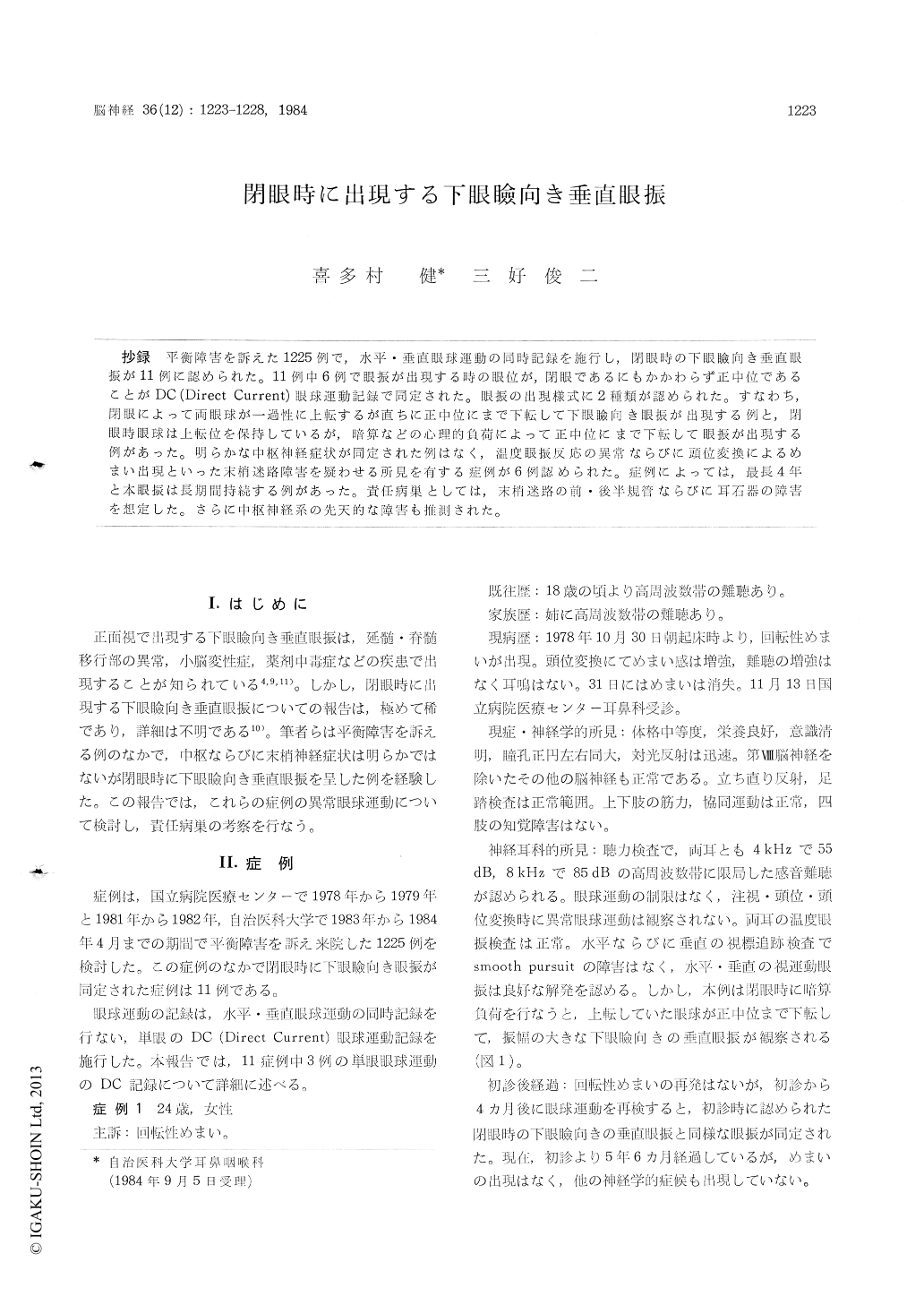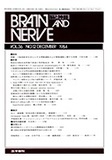Japanese
English
- 有料閲覧
- Abstract 文献概要
- 1ページ目 Look Inside
抄録 平衡障害を訴えた1225例で,水平・垂直眼球運動の同時記録を施行し,閉眼時の下眼瞼向き垂直眼振が11例に認められた。11例中6例で眼振が出現する時の眼位が,閉眼であるにもかかわらず正中位であることがDC (Direct Current)眼球運動記録で同定された。眼振の出現様式に2種類が認められた。すなわち,閉眼によって両眼球が一過性に上転するが直ちに正中位にまで下転して下眼瞼向き眼振が出現する例と,閉眼時眼球は上転位を保持しているが,暗算などの心理的負荷によって正中位にまで下転して眼振が出現する例があった。明らかな中枢神経症状が同定された例はなく,温度眼振反応の異常ならびに頭位変換によるめまい出現といった末梢迷路障害を疑わせる所見を有する症例が6例認められた。症例によっては,最長4年と本眼振は長期間持続する例があった。責任病巣としては,末梢迷路の前・後半規管ならびに耳石器の障害を想定した。さらに中枢神経系の先天的な障害も推測された。
We studied eye movements and clinical findings in 1225 patients with complaints of dizziness. Downbeat nystagmus was demonstrated in 11 pa-tients during eye closure. Simultaneous vertical and horizontal eye recordings were examined to demonstrate vertical eye position during eye closure. Downbeat nystagmus appeared on midline position even during eye closure in six patients. An electrooculography was demonstrated in three out of above six patients. A 24-year-old woman (Case 1) complained of a single spell of vertigo. There was no remarkable finding on neurological examination. An audiogram was an abrupt type sensorineural hearing loss in both ears. A caloric test was normal. Horizontal and vertical smooth pursuit was normal. Optokinetic nystagmus showed normal response in both horizontal and vertical planes. Both eyes were elevated on eye closure. They were depressed to the midline position with mental tasking and downbeat nystagmus appeared. A 68-year-old man (Case 2) had a history of diz-ziness on walking of three-year duration. On exa-mination neurological findings were normal. A caloric test was normal in both ears. Optokinetic nystagmus and smooth pursuit were normal in both horizontal and vertical eye recordings. He had a transient eye elevation on eye closure. Both eyes immediately came downward to midline posi-tion and downbeat nystagmus was demonstrated. His nystagmus had persisted for four years. A 68-year-old woman (Case 3) complained of posi-tional vertigo of seven-month duration. Neurolo-gical findings were normal. A caloric test was normal. There was a conductive hearing loss on the left ear. The right ear showed a normal audio-gram. Optokinetic nystagmus and smooth pursuit were normal in both horizontal and vertical eye movements. Eye elevation upon closure was per-sistent or transient in this patient. As it was transient, both eyes depressed to the midline im-mediately after eye closure and downbeat nystag-mus was demonstrated during eye closure. Both eyes could sometimes keep their elevated position during eye closure on the same day recordings. On that occasion a mental task made downward displacement of both eyes and downbeat nystagmus was demonstrated in the primary position during eye closure. There was no change in her nystag-mus one year later. Clinical findings in 11 patients were summarized as follows: 1) abnormal caloric test results in 4 patients, 2) positional vertigo in 2 patients, 3) no neurological findings except for cochleovestibular disorder. Primary downbeat nystagmus has been well described by many au-thors. Lesions of the floor of the fourth ventricle or the cerebellar nodulus and flocculus are sug-gested to produce primary downbeat nystagmus. There are very few studies, however, that deal with downbeat nystagmus during eye closure. Al-though our study provided few information on the pathophysiology of this nystagmus, peripheral vestibular endorgans are suggested to produce nystagmus. In addition, there should be expected a some kind of congenital defect in the central nervous system which exhibits downbeat nystag-mus during eye closure.

Copyright © 1984, Igaku-Shoin Ltd. All rights reserved.


